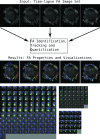The Focal Adhesion Analysis Server: a web tool for analyzing focal adhesion dynamics
- PMID: 24358855
- PMCID: PMC3752736
- DOI: 10.12688/f1000research.2-68.v1
The Focal Adhesion Analysis Server: a web tool for analyzing focal adhesion dynamics
Abstract
The Focal Adhesion Analysis Server (FAAS) is a web-based implementation of a set of computer vision algorithms designed to quantify the behavior of focal adhesions in cells imaged in 2D cultures. The input consists of one or more images of a labeled focal adhesion protein. The outputs of the system include a range of static and dynamic measurements for the adhesions present in each image as well as how these properties change over time. The user is able to adjust several parameters important for proper focal adhesion identification. This system provides a straightforward tool for the global, unbiased assessment of focal adhesion behavior common in optical microscopy studies. The webserver is available at: http://faas.bme.unc.edu/.
Conflict of interest statement
Figures

References
LinkOut - more resources
Full Text Sources
Other Literature Sources
Molecular Biology Databases

